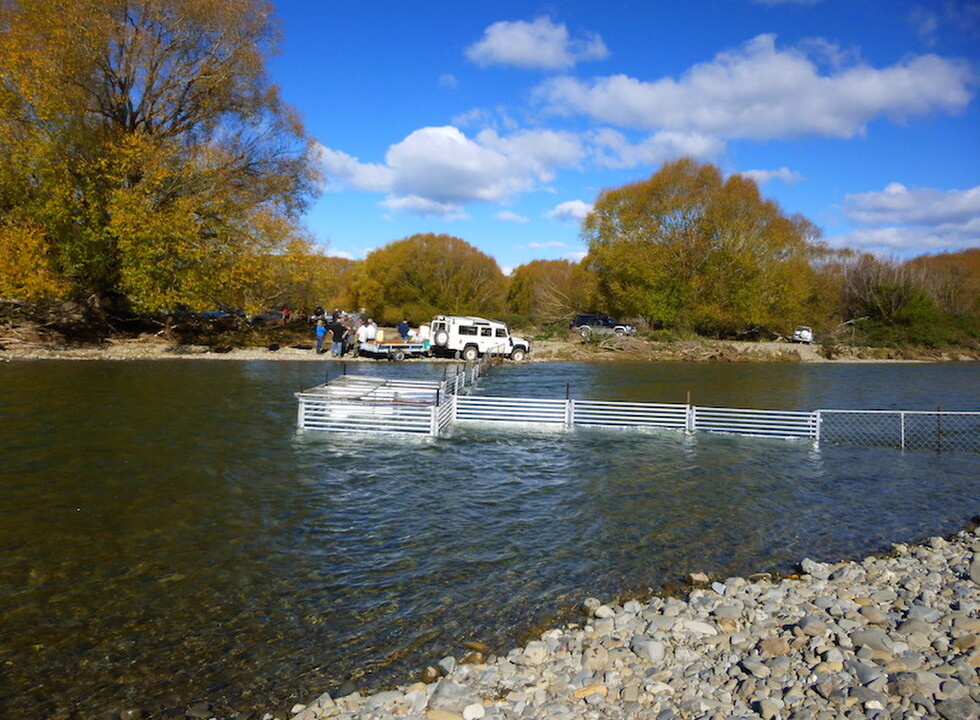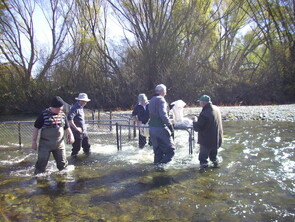Our aim is to increase the wild salmon population in the Waitaki River.
We achieve this by trapping and raising salmon brood stock, and releasing them a year later at a weight of around 100gm. We don't know why the salmon population is declining, but rearing them to this size gives them a much better chance against their natural predators.
The 12 month old smolt are released into the wild, they go out to sea to feed and grow, and then return in 2-3 years to spawn.
We tag the fish before they are released by removing their adipose fin. Anglers who catch a salmon that has been tagged this way are asked to take the fish to either the Glenavy Hotel, Waimate Outdoors or Oamaru Sports and Outdoors to get weighed. Doing so means the anglers that catch the fish are eligible to enter the draw for a $100 sports voucher.
It's really important that this happens as it's our only means of establishing an approximate number of salmon that have returned to the river for spawning.
HOW IT'S DONE
Starting in April, we trap salmon in the Haka River. Our members go on a roster to camp overnight, to keep the traps free of weed and release trapped trout. We spend anywhere from 2 weeks to 2.5 months camping there.
The process of getting the eggs is known as stripping. The eggs are stripped into a bowl, and brought to our incubation shed at Welcome Stream, further down the Waitaki River. We also bring the Jacks down to fertilise the eggs. The jack's milt is mixed with the eggs and put into incubation trays.
The squigglys stay in the incubation trays for 20 days, the yolk sac remains and is ingested as nutrients.
They are then introduced to these steel troughs, and are fed automatically every 30 minutes during daylight hours.
Prior to releasing the salmon we tag them by removing the Adipose Fin. This enables us to get an idea of how many salmon return to the Waitaki to spawn.
If an angler catches a fish with the adipose fin removed they are requested to bring the fish to either the Glenavy Hotel, Oamaru Sports and Outdoors or Waimate Outdoors for verification.
20 female salmon (hens) per season will give us enough eggs. We also trap male salmon (jacks) as we need their milt to fertilise the eggs. Trout spawn further up river so we release them and notify Fish and Game.
The eggs and milt are left for 20 - 40 minutes in a bowl and then tipped into these incubation trays. After around16 days one eye will appear, in another 16 days both eyes appear. In 10 more days a silver disc appears around the eyes, in another 2 - 4 more days the salmon hatch from the eggs.
When they weigh around 3 - 4 grams on average, they are transferred to our raceways at either Welcome Stream or Bell's Pond. The amount fed to the fish increases as they grow. Interestingly Salmon won't eat the food once it hits the ground, unlike trout.
The salmon are released into the wild.......and then the whole process starts again. It's back up to the Haka River to trap salmon.
The salmon are put in a holding pen until 'ripe'. Jacks and hens are kept seperate at this stage. These salmon are up in the Haka river for the sole purpose of releasing and fertilising eggs, it is the end of their life cycle.
From fertilisation to hatching takes around 53 days, it's dependant on the temperature of the water.
The hatched salmon are known officially as Alevin, we call them 'squigglys'.
The salmon remain in the raceways at Bell's Pond or Welcome Stream until they are approximately 70 - 100 grams. The salmon are now known officially as smolt.
It's taken a number of years, and trial and error to get where we are today. To read about the history of the project click here.












